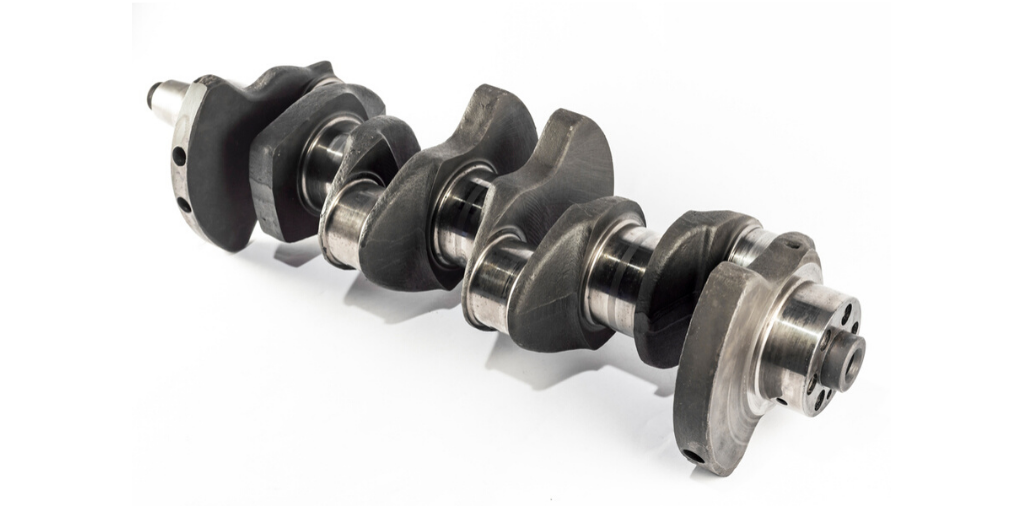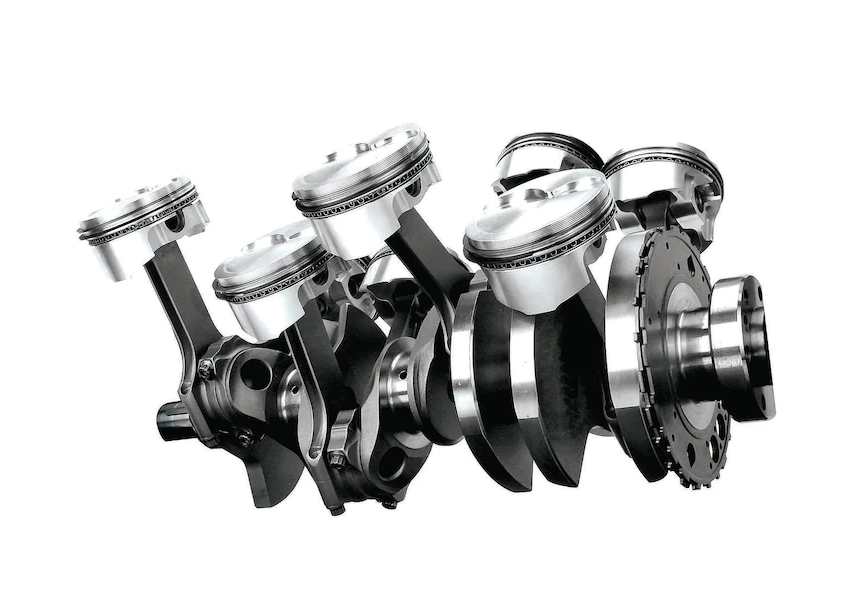Most Common of Crankshaft is the one-piece crankshaft, which is widely used in passenger cars and light vehicles.
The one-piece crankshaft is preferred due to its effectiveness, affordability, and simple design. It is primarily composed of cast iron or forged steel, depending on the specific application and performance requirements.

Introduction
The introduction provides an overall preview of the in-depth knowledge and perspectives that are to be covered on the subject of crankshafts.
Definition of a Crankshaft
A crankshaft is a moving part of an internal combustion engine (ICE) that converts reciprocating motion of the pistons into rotational motion. This is crucial in the overall operation of the vehicle, allowing it to move forward or backward. The crankshaft consists of main journals, crank pins, crank arms (or crank throws), and a flange.
Importance of a Crankshaft in an Engine
The crankshaft, being a core component of the engine, plays a vital role in the vehicle’s function and performance. It has the responsibility of converting linear piston motion into rotational motion, thereby enabling the wheels of the vehicle to rotate and the car to move. The crankshaft works in conjunction with several other parts like the connecting rod, cylinder, and piston to ensure the proper functioning of the engine. Its health and durability directly influence the lifespan and performance of a vehicle’s engine.
Types of Crankshafts
The crankshaft, one of the critical components of an engine, comes in different designs to accommodate various engine specifications and requirements. Here are the primary types:
One-piece Crankshafts
A one-piece crankshaft is a solid piece of metal that is shaped and machined into the required configuration. It is mostly used in simpler, smaller engines like those in motorcycles, due to its simplicity, reliability, and cost-effectiveness. These crankshafts are typically made from steel or iron.
Two-piece Crankshafts
Two-piece crankshafts consist of two separate components joined together, often a shaft and a crankpin.
The Most Common Crankshaft
Among various types, the one-piece crankshaft is by far the most common, primarily used in passenger cars and light vehicles due to its effectiveness and affordability.
Characteristics of the Most Common Crankshaft
The one-piece crankshaft has a straightforward design, with the entire component machined from a single piece of metal, typically cast iron or forged steel. This design allows for high durability and a good balance between cost and performance.
Its main components include the main journals, rod journals (also known as crankpins), counterweights, and flanges.
Applications and Usage
One-piece crankshafts find their applications primarily in internal combustion engines of light to medium-duty vehicles, such as passenger cars, light trucks, and motorcycles.
Production of Crankshafts
The production process of crankshafts involves careful material selection and specialized manufacturing processes to ensure the resulting product meets the required quality and performance standards.

Materials Used in Crankshaft Construction
The selection of materials for the construction of crankshafts is a crucial factor as it determines their durability, strength, and performance.
Cast iron crankshafts are relatively cheap, easy to manufacture, and offer decent strength and durability, making them suitable for most standard use cases.
Forged steel crankshafts, on the other hand, are more robust, more resistant to wear and tear, and can withstand higher pressures and temperatures.
Manufacturing Processes
- Machining: The cast or forged component is then machined to achieve the precise shape and dimensions required for the crankshaft. This involves processes such as turning, milling, and grinding.
- Surface Finishing: Finally, the crankshaft undergoes surface finishing processes, such as polishing, to reduce friction and improve its appearance.
- Balancing: The crankshaft is then balanced by drilling holes in the counterweights. This step is crucial for reducing vibration and ensuring smooth engine operation.
The entire manufacturing process must adhere to strict quality control measures to ensure the final product meets the required specifications and performance standards.
Factors Influencing Crankshaft Selection
Several factors influence the choice of crankshaft for a particular application. These include the type of engine, cost considerations, and durability requirements, among others.
Engine Type and Requirements
The type of engine greatly influences the choice of crankshaft. For example, a lightweight, simple engine such as those in motorcycles might require a one-piece cast iron crankshaft due to its simplicity and affordability. On the other hand, a heavy-duty engine, such as those in commercial vehicles or high-performance cars, might require a forged steel crankshaft for its strength and durability.
Cost Considerations
Cost is always a crucial factor in the selection of components. Cast iron crankshafts are generally cheaper and easier to manufacture than their forged steel counterparts. Therefore, they are often the choice for standard, non-performance applications.
Durability and Maintenance
The longevity and maintenance requirements of a crankshaft are also important considerations. Forged steel crankshafts are more durable and less prone to wear and tear than cast iron ones, leading to lower maintenance requirements and longer service life. However, they are also more expensive. Therefore, the decision between a cast iron and forged steel crankshaft often comes down to a balance between upfront costs and long-term maintenance and replacement costs.
Innovations in Crankshaft Design
The field of crankshaft design has seen numerous advancements and innovations over the years. These developments aim to improve performance, efficiency, and durability, while also reducing weight and manufacturing costs.

Recent Technological Advances
Technological advancements have led to the development of new materials and manufacturing processes for crankshafts.
Additive manufacturing, also known as 3D printing, is another promising development. This technique allows for the production of complex geometries and structures that would be difficult or impossible to create with traditional manufacturing processes. This could lead to the creation of crankshafts with optimized shapes for better balance and reduced weight.
Other advances include improvements in machining and finishing processes, leading to greater precision and smoother surfaces, which can increase efficiency by reducing friction.
Impact of Innovations on Crankshaft Use
The innovations in crankshaft design and manufacturing can have significant impacts on their usage. For instance, lighter, more efficient crankshafts can improve fuel efficiency and performance, while stronger, more durable crankshafts can increase the lifespan of an engine and reduce maintenance costs.
In addition, advances in manufacturing processes can lead to cost reductions, making higher-performance crankshafts more affordable and therefore more accessible for a wider range of applications. On the other hand, the adoption of new materials and technologies can also present new challenges, such as the need for specialized equipment or techniques for installation and maintenance.
Potential Future Developments in Crankshaft Technology
Crankshaft technology, like all aspects of automotive technology, is subject to ongoing evolution and development.
Material Innovations
One area where further development is likely is in the area of materials. While cast iron and forged steel remain the most common materials for crankshaft construction, the search is on for lighter, stronger materials that can further enhance engine performance and efficiency.
Composite materials, which combine the properties of different materials to create a superior end product, are of particular interest.The use of nanotechnology in material science could also lead to the development of novel materials with improved properties.
Manufacturing Innovations
3D printing, or additive manufacturing, allows for the creation of complex parts with a high degree of precision. This technology could enable the production of crankshafts with intricate designs and features that are not currently possible with traditional manufacturing methods.
Moreover, 3D printing allows for the use of a wider range of materials in crankshaft construction, potentially paving the way for the use of novel materials in future designs.
Design Innovations
Future innovations in crankshaft design could also come from the increased use of computer-aided design and simulation tools.
In conclusion, while the basic function and principles of crankshaft operation remain the same, the methods of designing and manufacturing these crucial engine components continue to evolve. It is clear that the future of crankshaft technology holds much promise and potential.
